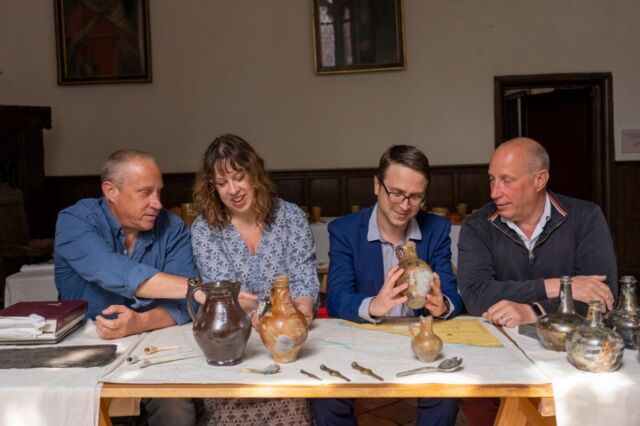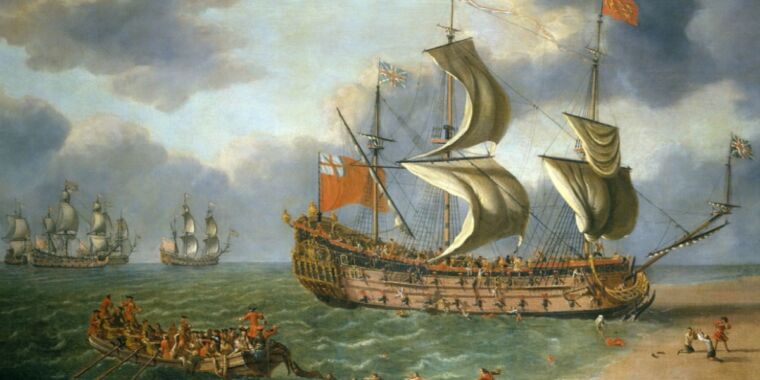In 1682, a royal ship carrying the heir to the English throne ran aground and sank off the coast of Norfolk. The wreck was discovered in 2007 by two brothers and has remained a closely guarded secret until now.
At 5:30 a.m. on May 6, 1682, a ship named the Gloucester ran aground on a sandbar off the coast of Norfolk and sank within the hour. Among the passengers was James Stuart, Duke of York and future King James II of England, who escaped in a small boat just before the ship sank. If he had died, British history might have been very different. Yesterday we learned that the wreck of the Gloucester was discovered in 2007 by a couple of brothers, although it took several more years to verify that the wreck was indeed the wreck Gloucester† Its discovery has been a closely guarded secret until now.
“Due to the conditions of the sinking, this can be claimed as the most significant historic maritime discovery since the raising of the Mary Rose [Henry VIII’s favorite warship] in 1982,” said Claire Jowitt, maritime history expert at the University of East Anglia (UEA). “The discovery promises to fundamentally change the understanding of 17th-century social, maritime and political history.” Jowitt is the author of a new published article in the journal English Historical Review, outlining the significance of the find.
This was a particularly fraught historical period, filled with political intrigue and religious tension. In January 1649, King Charles I was executed and Oliver Cromwell came to power as Lord Protector of the Commonwealth of England, Ireland and Scotland. The executed king’s sons, Charles (the heir) and James, fled to France where they lived in exile.
Charles II regained the English throne when the Commonwealth collapsed in 1660, naming James (a devout Catholic) Duke of York and his heir presumptive. This did not go down well with English Protestants, who formed the Country Party (later the Whigs) and sought to exclude James from the line of succession, creating a constitutional crisis. The maligned James ended up living in Scotland for several years. Nevertheless, the “crisis of exclusion” eventually ended and James was crowned king when Charles II died of a stroke in 1685.
public domain
Three years before his coronation, the future King James II set course for the Gloucester with his heavily pregnant second wife for a meeting with the Scottish Parliament. Other passengers included the Earl of Roxburgh, John Churchill (future Duke of Marlborough), and Colonel George Legge, an ancestor of George Washington.
The English diarist Samuel Pepys was a passenger on the royal yacht that sits next to the Gloucester in the royal fleet and recorded the harrowing experience of the sinking for posterity in a letter to a friend. He thought the event would “become the talk of the town,” describing victims being pulled from the water half-dead.
There is no data on the number of deaths, according to Jowitt, but she estimates it was between 130 and 250 of the approximately 330 passengers. And Pepys believed it could have been a lot worse. “Had this failed but two hours earlier in the morning, or the yachts at the usual distance they had stood all the time before, the Duke himself and every soul would have perished,” he wrote.
Historic Shipwrecks in Norfolk
According to Jowitt, the night before the sinking, James had argued with the… Gloucester’s pilot on the best course to prevent the Norfolk sandbars from seizing. He thought they had already cleared that area. “It was James’ course they took when the disaster happened, but he took no responsibility, scapegoated others and got the pilot locked up by court martial,” she said at a news conference.
The man who presided over the court-martial suspected a cover-up, and other crucial witnesses to the sinking—including Churchill, James’ closest adviser—”apparently began to think less of James after the Gloucester sunk,” Jowitt said. In addition, according to survivors’ stories, James stubbornly remained on board until the last possible moment, effectively sentenced many others to death as protocol dictated that they could not leave the ship for royalties. Subsequent accounts claimed that James placed the survival of his dogs and priests above the survival of others.

University of East Anglia
That reputational damage tarnished James II’s rule from the start. Several eyewitnesses to the sinking saw him as unfit to rule and later played a part in the successful plot to remove him from the throne in 1688, known as the ‘Glorious Revolution’. His daughter Maria and her husband William of Orange (both Protestants) took over the throne, and the rest is history.
The Gloucester remained half-buried in the seabed for over 300 years until Julian and Lincoln Barnwell joined it. The brothers are Norfolk printers and avid licensed divers. Lincoln Barnwell said he was hoisting the… Mary Rose from his watery resting place as a child, and that experience inspired the search for the Gloucester† They began the search in 2003 and continued for the next four years, covering some 4,000 miles of terrain.

